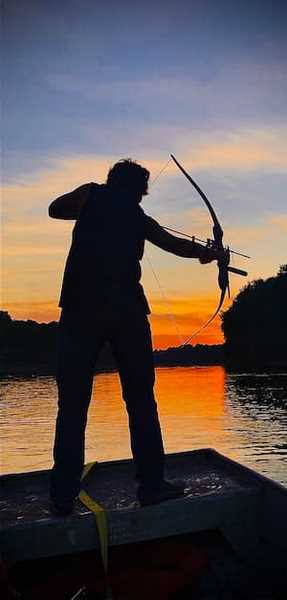
The long months between spring gobbler and deer seasons can be brutal for diehard bowhunters. It’s a great time to get in some extra target practice, but bowfishing can also help tide you over and provide a more fun form of prep for the fall.
Unlike bowhunting for big game, bowfishing can be a pretty low-pressure activity. At the right place and the right time, you’ll have dozens of shot opportunities in a single session.
While you could go all out with a powered boat sporting LED lights for nighttime shooting, you can get by walking the creek banks with some relatively inexpensive equipment.
Full bowfishing setups run as low as a couple hundred bucks, or you can modify an old hunting rig with a few accessories. A bowfishing reel, rest, arrows, and points are all you really need to get started.
And if you don’t want to bother buying a bowfishing rig or finding a spot, booking a guided trip for you and your buddies will run you a fraction of what a hunt would cost — including all the necessary gear.
Because you’re usually shooting at a much smaller target, bowfishing rigs boast much lower draw weights than hunting bows. So it’s a great sport for your family members who’ve never even shot a bow before or archers who are nursing an injury.
Although you’ll likely get lots of opportunities to shoot, you’ll need them. Refraction distorts your vision and makes it difficult to judge a fish’s depth in the water — plus you’ll be shooting at a moving target. To account for refraction, you should aim a few inches low for every foot of depth the fish is swimming below the surface. When you think you’re aiming too low, aim a little lower.
It might take quite a few shots to get the hang of it, but there’s no need to stress because you’re not blowing a once-per-year bowhunting shot — there will always be more fish. Expect to miss significantly more shots than you make.
Depending on where you live, legal species to bowfish include carp, catfish, gar, sting rays, and more. And in most places, you’ll just need an affordable fishing license to begin bowfishing.
So this summer, hit the water with your bow in hand. If you have yet to try bowfishing, you’re missing out.

Not to mention , it’s a hoot! The only down side to bowfishing at night is the bugs. And they sometimes (always) drive me crazy.
rk, the bugs are the only downside!
BowBully,
Said: “While you could go all out with a powered boat sporting LED lights for nighttime shooting, you can get by walking the creek banks with some relatively inexpensive equipment.”
You could however also find a middle ground and use a kayak or a SUP (Stand Up Paddle) board; some of them even have electric motors, fish finders and LED light systems!
They can also get into more FISHEE water in many instances than even a low draft Bass Boat.
shootski
shootski, I know of a few people who’ve had success bowfishing from kayaks!
Rigging your fishing line to the point and the arrow is a challenge. Lots of options for the attachment that is secure but does not affect the arrow’s flight too much. If you just tie dacron line to a fixed bow reel and the shaft near the nock then hit a 30 # carp, better have some way to slow it before it hits the end. Otherwise you’ll lose your arrow. That’s when a strong spin-cast reel comes into its own. Handlining a tail-hit gar can make you wish you had heavier callouses on your hands.
I liked wading shallow water (5-10″) for carp and gar. If you walk slowly, they offer plenty of shots under 10 yds. Inexpensive compound worked for me.
jumpin, the gear can be a bit tricky which is why I recommend kits for beginners – my favorite is a Muzzy takedown recurve!